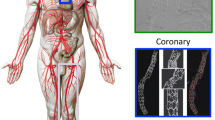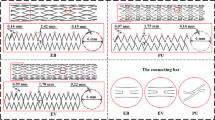Abstract
Background
The implanted non-vascular stent is prone to fatigue fracture due to the periodic cyclic load caused by long-term physiological motion in the non-vascular lumen.
Objective
To effectively study and predict the fatigue performance of non-vascular stents, an experimental setup was designed to simulate and conduct fatigue performance tests on non-vascular stents under various loads. This design simplified the periodic cyclic loads generated within non-vascular lumens, in accordance with the physiological motion patterns of non-vascular lumens, into pulsatile loads.
Methods
To meet the requirements of different stents and various fluctuating load conditions during testing, the relationship between test conditions and the fatigue load of the stent was studied based on Fluent.
Results
A fatigue test device with a special load module was built and used to complete the fatigue performance test of a group of esophageal stents. It can be found that the experimental device can satisfy the control and application of the fatigue load of the stent, and can effectively realize the testing requirements of the fatigue performance of the stent.
Conclusion
In this paper, a non-vascular stent fatigue in vitro test device that can simulate the fluctuating load of a non-vascular lumen is designed. The results of flow field simulation, fatigue simulation, and actual fatigue test show that the device can meet the needs of fatigue test and has good versatility and operability.










Similar content being viewed by others
Data Availability
The data underlying this article are available in the article and in its online supplementary material.
References
Wlodarczyk JR, Kużdżal J (2018) Stenting in Palliation of Unresectable Esophageal Cancer. World J Surg 42:3988–3996. https://doi.org/10.1007/s00268-018-4722-7
Xue W, Gao J, Lin J, Wang F, Guan G, Wang L (2018) Deformation mechanisms of prototype composite braided stent-grafts in bending fatigue for peripheral artery application. J Mech Behav Biomed Mater 78:74–81. https://doi.org/10.1016/j.jmbbm.2017.10.037
Meoli A, Dordoni E, Wu W, Petrini L, Migliavacca F, Dubini G, Pennati G (2012) Fatigue behaviour of nitinol peripheral stents: computational simulations of in vitro set-ups. J Biomech 45:S640. https://doi.org/10.1016/S0021-9290(12)70641-3
Fitzka M, Rennhofer H, Catoor D, Reiterer M, Lichtenegger H, Checchia S, di Michiel M, Irrasch D, Gruenewald TA, Mayer H (2020) High speed in situ synchrotron observation of cyclic deformation and phase transformation of superelastic nitinol at ultrasonic frequency. Exp Mech 60:317–328. https://doi.org/10.1007/s11340-019-00562-8
Kapnisis K, Constantinides G, Georgiou H, Cristea D, Gabor C, Munteanu D, Brott B, Anderson P, Lemons J, Anayiotos A (2014) Multi-scale mechanical investigation of stainless steel and cobalt–chromium stents. J Mech Behav Biomed Mater 40:240–251. https://doi.org/10.1016/j.jmbbm.2014.09.010
Batgerel T, Aguilar LE, Iv FV, Yang SH, Park C-H, Kim CS (2019) The Design and Experimental Application of an Esophageal Stent Migration and Fatigue Testing Device. J ICROS 25:140–148. https://doi.org/10.5302/J.ICROS.2019.18.0215
Nagaraja S, Chandrasekar V, Ormonde D, Hickey H, Lipschultz K, Chao C, Vilendrer K, Pelton AR (2018) The Impact of Fatigue Testing and Surface Processing on Nickel Release in Nitinol Stents. Shap Mem Superelasticity 4, 462–471. https://doi.org/10.1007/s40830-018-00196-0
Ni X, Wang G, Long Z, PAN C (2012) Analysis of mechanical performance of braided esophageal stent structure and its wires. J SE Univ 28:457–463
Wang B, Ni X, Pan C (2021) Research Progress in Fatigue Properties of Esophageal Stent. J Med Biomech 36:324–329. https://doi.org/10.16156/j.1004-7220.2021.02.024
Gu X, Liu L, Ni Z, Cheng J, Long Z (2013) Investigation on the design and experimental application of novel fatigue testing device for esophagus stent. In: 2013 IEEE International Conference on Mechatronics and Automation. pp 407–411. IEEE, Takamatsu, Kagawa, Japan. 10/gph7m7
Batgerel T, Aguilar LE, Iv FV, Yang SH, Park CH, Kim CS (2019) The Design and Experimental Application of an Esophageal Stent Migration and Fatigue Testing Device. J Inst Control Robot Syst 25:140–148. https://doi.org/10.5302/J.ICROS.2019.18.0215
Li H (2020) Research and development of fatigue test system for vascular stent (In Chinese ). New Technol New Prod China 13:52–54. https://doi.org/10.13612/j.cnki.cntp.2020.13.021
Li Z, Yan W, Feng H (2020) Safety performance of self-expandable NiTi alloy stent ( In Chinese ). J Biomed Eng 37:334–339
Hu Y, Yu J, Qian S, Cao S, Chen X (2020) The development of pneumatic biomimetic esophageal peristaltic soft actuator. Mach Des Manuf Eng 49:29–33
Chen F, Li X, Xu P (2015) Structure Design and Experimental Study for a Novel Pneumatic-driven Soft-bodied Actuator Mimicking Esophageal Peristalsis. Chin Hydraul Pneum 7:116–119
Omari T, Zifan A, Cock C, Mittal RK (2022) Distension contraction plots of pharyngeal/esophageal peristalsis: next frontier in the assessment of esophageal motor function. Am J Physiol-Gastroint Liver Physiol 323:145–156. https://doi.org/10.1152/ajpgi.00124.2022
Liu L, Suo W (2019) Numerical simulation of airway closure in dependent regions of lower respiratory tract in acute respiratory distress syndrome patients. Chin J Med Imaging Technol 35:1722–1726. https://doi.org/10.13929/j.1003-3289.201904125
Watanabe J, Watanabe M (2019) Anatomical factors of human respiratory tract influencing volume flow rate and number of particles arriving at each bronchus. Biocybern Biomed Eng 39:526–535. https://doi.org/10.1016/j.bbe.2019.03.004
Liu Z, Sun H, Jin G, Liu B (2016) Study of the Airflow Patterns and of the Characteristics of Bio-Aerosol Nanoparticle Deposition in Human Upper Respiratory Tracts Based on Computed Tomography Scanning Reconstruction. Sci Adv Mater 8:987–996. https://doi.org/10.1166/sam.2016.2654
Kiasadegh M, Emdad H, Ahmadi G, Abouali O (2020) Transient numerical simulation of airflow and fibrous particles in a human upper airway model. J Aerosol Sci 140:105480. https://doi.org/10.1016/j.jaerosci.2019.105480
Wall WA, Rabczuk T (2008) Fluid–structure interaction in lower airways of CT-based lung geometries. Int J Numer Meth Fluids 57:653–675. https://doi.org/10.1002/fld.1763
Ma B, Lutchen KR (2006) An anatomically based hybrid computational model of the human lung and its application to low frequency oscillatory mechanics. Ann Biomed Eng 34:1691–1704. https://doi.org/10.1007/s10439-006-9184-7
McGrath DJ, Thiebes AL, Cornelissen CG, O’Shea MB, O’Brien B, Jockenhoevel S, Bruzzi M, McHugh PE (2017) An ovine in vivo framework for tracheobronchial stent analysis. Biomech Model Mechanobiol 16:1535–1553. https://doi.org/10.1007/s10237-017-0904-8
McCool FD (2006) Global physiology and pathophysiology of cough. Chest 129:48–53. https://doi.org/10.1378/chest.129.1_suppl.48S
Hegland KW, Troche MS, Davenport PW (2013) Cough expired volume and airflow rates during sequential induced cough. Front Physiol 4. https://doi.org/10.3389/fphys.2013.00167
Yao T, Wu B (2003) Physiology. People’s Health Publishing House, Beijing
Gregersenh (2006) Gastrointestinal biomechanics-a new perspective of gastrointestinal dynamics. People’s Health Publishing House, Beijing
Misra JC, Maiti S (2012) Peristaltic transport of a rheological fluid: model for movement of food bolus through esophagus. Appl Math Mech 33:303–319
Lu, L. (2002) A simple model on esophageal peristaltic transport (in Chinese). Chin J Med Phys 19:50–53
Dirven S, Xu W, Cheng LK (2015) Sinusoidal peristaltic waves in soft actuator for mimicry of esophageal swallowing. IEEE-ASME Trans Mechatron 20:1331–1337. https://doi.org/10.1109/TMECH.2014.2337291
Ni X, Pan C, Wang Y, Ni Z (2009) Research on numerical simulation and structural fatigue life for esophagus stent. Chin Mech Eng 20:2856–2860
Ni X, Zhang Y, Sui B, Pan C (2018) Research on the stress and fatigue performance of braided esophageal stents with different end shapes (in Chinese). Mach Des Manuf 12:128–131. https://doi.org/10.19356/j.cnki.1001-3997.2018.12.032
Ni X, Zhao H, Yin H, Zhang Y, Pan C (2018) Influence of end shapes on biomechanical behavior of the stent-esophagus coupling system. J Med Biomech 33:101–107. https://doi.org/10.16156/j.1004-7220.2018.02.002
Acknowledgements
This research was partially supported by the National Natural Science Foundation of China (Grant No: 51005124). The authors thank Dr. Weiyu Chen, Dr. Yunfeng Gu, and Dr. Dong Jiang from the Department of Mechanics of Nanjing Forestry University for the helpful guidance provided in building the test device and writing the article. The authors would like to thank the associate editors and the reviewers for their useful feedback that improved this paper.
Funding
Six Talent Peaks Project in Jiangsu Province, Grant/Award Number: GDZB-040;
National Natural Science Foundation of China, Grant/Award Number: 51005124.
Author information
Authors and Affiliations
Corresponding author
Ethics declarations
Ethical Approval
Not required.
Competing Interest
None declared.
Additional information
Publisher's Note
Springer Nature remains neutral with regard to jurisdictional claims in published maps and institutional affiliations.
Supplementary Information
Below is the link to the electronic supplementary material.
Rights and permissions
Springer Nature or its licensor (e.g. a society or other partner) holds exclusive rights to this article under a publishing agreement with the author(s) or other rightsholder(s); author self-archiving of the accepted manuscript version of this article is solely governed by the terms of such publishing agreement and applicable law.
About this article
Cite this article
Li, Y., Li, J., Mao, M. et al. Investigation on the Design and Application of Hydraulic Loading Fatigue Test Device for Non-Vascular Stent. Exp Tech (2023). https://doi.org/10.1007/s40799-023-00685-7
Received:
Accepted:
Published:
DOI: https://doi.org/10.1007/s40799-023-00685-7




